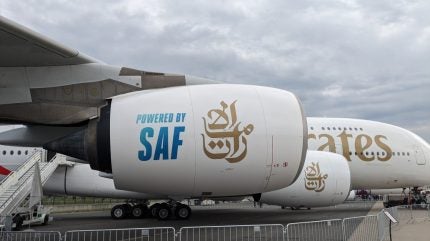
There is no silver bullet, but the industry really does need sustainable aviation fuel (SAF), according to industry figures at ILA Berlin.
Alternatives to kerosene are hard to avoid at air shows and industry events, but agreement is much harder to find. Some will tell you that eVTOLs and battery-electric flight are the solution to the aviation world’s issues, and an equal number will swear by hydrogen power cell development.

Discover B2B Marketing That Performs
Combine business intelligence and editorial excellence to reach engaged professionals across 36 leading media platforms.
Perhaps it is unsurprising, then, that e-fuels start-up Spark’s CTO and co-founder Arno Zimmermann told Airport Technology: “No matter who you ask, SAF is the biggest thing.”
With at least three (if not more) potential routes for sustainable aviation and the end goal of net-zero flight, the second day of ILA launched into a passionate discussion on the current picture of the emerging sector.
“Engineering wise, it is exciting times,” said Roland Gerhards of the Centre of Applied Aeronautical Research. “We are working on hydrogen for 15 years. Now the focus is completely different; it has increased hugely. New focus, new speed,” he explained.
Although Gerhards and his colleagues might have more experience than most, the commercial side of the sector is clearly ready and willing to play catch-up.

US Tariffs are shifting - will you react or anticipate?
Don’t let policy changes catch you off guard. Stay proactive with real-time data and expert analysis.
By GlobalDataTodd Spierling, principal technical fellow at Collins Aerospace (part of RTX), put it plainly: “My position did not exist two years ago.”
Brazilian manufacturer Embraer is another giant working on the future of its business. Three years ago it launched its Embraer-X start-up and tech accelerator, and the company’s sustainable product lead Lucian Ribeiro Monteiro said that change in aviation might be slow, “but it is happening”.
“We are really… doing some tangible actions,” she told the conference. Despite the industry’s reticence to begin the process of change, she said the influence of society at large and the movement of environmental concern to the mainstream has spurred on the appetite for change we see today.
“It has become something we are more ashamed about… it is a bit late [but] we are engaging. It is what we have to do,” she remarked.
So what is holding back progress? Money and regulations are at the top of the list.
“The German Government needs to loosen up its tax breaks to assist R&D. It is a tremendous investment opportunity [for European countries],” explained Zimmermann. His company was recently at the sharp end of political fluctuations, with a financing agreement backed by the German Government ready to go – until a change of political winds shut the plan down.
“We would really urge the German Ministry of Transport to get back to [investing in e-fuels],” he said.
Spierling also pointed to the patchwork international SAF frameworks as “a large sticking point”.
“What does 100% SAF look like? What are the certification frameworks needed?” he said.
Despite its very real issues, the industry as a whole is determined that SAF is the only current viable solution to reducing aviation’s impact on the climate.
“There is room for hydrogen, but look into any study and it is always conventional hydrocarbon sustainable fuels that is making a difference until 2050,” Zimmermann told Airport Technology.
Gerhards agreed. “There is no silver bullet solution. The laws of physics are still there, so of course, battery electric [has] the highest efficiency, but we will not see battery electric flights for longer ranges. Hydrogen is the next step, but maybe not for long-range. So for flying across the ocean, we are going to have SAF as the only solution for the coming decades.”



